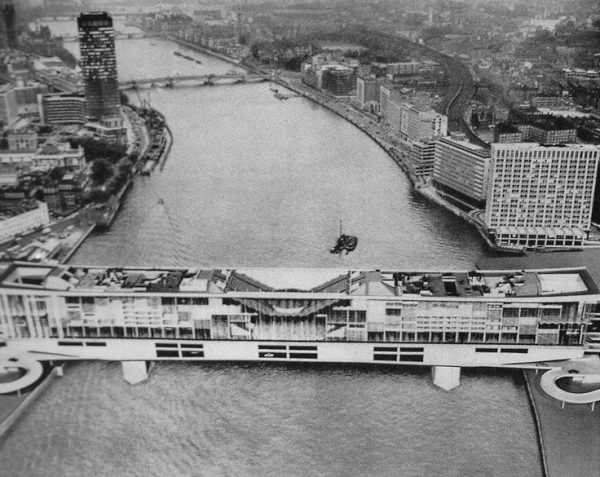Forget garden bridges and wobbly bridges and tower bridges, what we really need in London is a 7-story high crystal bridge! At least, that’s what was proposed in 1963 by the Glass Age Development Committee, an organisation set up by the glassmakers, Pilkington to promote the use of glass in architecture.
Although mainly a promo outlet for Pilkington, the group did come up with some quite independent ideas, and one of many was the Crystal Span, a 300-metre long glass-clad bridge to replace the existing road bridge at Vauxhall.
The plans called for it to be a full seven stories in height, with the lower floor being given over to road vehicles and parking for 300 vehicles.
The upper floors would have been for humans, and in a reflection of Old London Bridge, would have been lined with space for 52 shops and a travelator to make it easier for pedestrians to get from one side of the river to the other.
Apparently, in memory of the frost fairs, an ice rink was included.
(I am increasingly convinced that 1960s architects were obsessed with ice rinks)
Add in a 120-bed hotel, an offshoot of the Tate Gallery, a 500 seat theatre, and get ready for it — a roof garden — and you have a massive structure spanning the Thames. The entire bridge would have been 300 metres long and 39 metres wide.
For comparison, London Bridge is 269 metres long and just 32 metres wide.
Eric de Mare in Bridges of Britain described it as “a clumsy affair without gaiety but interesting as a development of the ancient housed bridges such as Old London Bridge.”
As with most of the ideas from the Committee which were to provoke thinking, the bridge was not intended to be a serious proposition for construction, but they commissioned Ove Arup to handle the engineering side of their design anyway.
Structurally, the bridge would have been made of a pair of double-decked concrete boxes for the road sections, that in turn supported the buildings above. A glass curtain surrounding the bridge and enclosing the pedestrian spaces would have hung from the sides of the bridge structure.
Sadly, the end result would probably have looked like just a very long glass “office block” floating across the Thames, built more to cram as much into a space than for any genuine architectural merit.
It seems that the bridge caused a bit of a stir and some support, but in the end, the London County Council declined to pick up the estimated £7 million (£132 million in 2017) construction costs, and the scheme was abandoned.
Sources
The Times, 27th Sept 1963
Architecture and Design For the Family in Britain, 1900-1970 by David Jeremiah
Crystal Span – The Latest Glass Age Project, Official Architecture and Planning, November 1963
The History of London’s Thames River Bridges from Richmond to the Tower by Brian Cookson









Another great find! Thank you for all your hard work!
Soon the be the Garden Bridge https://www.tcos.org.uk/single-post/2017/05/05/What-to-do-next
I have just finished watching the first in a three part series called Dreaming the impossible: unbuilt Britain (BBC4 at 20:00). This first episode featured Joseph Paxton’s Great Victorian Way and Geoffrey Jellicoe’s Motopia. There were also glimpses of the other projects you have featured in this series and a look at the revolution in glass structures that Pilkington’s ‘float glass’ manufacture enabled.
I daresay that if the Crystal bridge had ever been built, it would look like a lot of 60’s architecture does now, grim and probably neglected.
@TCOS London: the garden bridge has been scrapped by the Mayor of London.
Hello
Many thanks for the piece. Could you tell me please what publications the photograph and ‘Crystal Span’ architectural drawings are from. I would like to seek out a copy of each.
All the best
Dave
London SE17
Check out the list of sources at the bottom of the article.